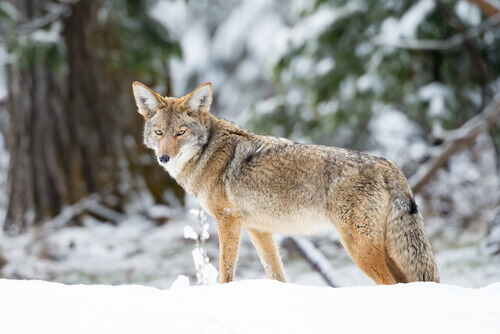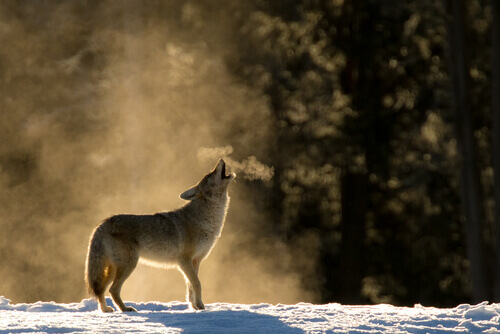The Typology and Behavior of the Coyote


Written and verified by the lawyer Francisco María García
The coyote is a carnivorous mammal that belongs to the canine family, which can be confused with a wolf or a wild dog. To distinguish it well, you need to look at the slenderness of its body and its intense yellow eyes. Its color and size can vary greatly, as there are at least 16 different varieties. This animal is present in the tales and legends of the Native North Americans and always appears as a very cunning and dynamic animal. Below, we’ll see some elements to better understand the typology and behavior of the coyote.
Habitat
The coyote lives mainly in North and Central America, but also in some regions of South America. Some live in mountainous regions and others in the plains or even in hot desert areas.
It has a great capacity for adaptation, which is why it’s extended its habitat in such a surprising way. Coyotes can live in cold or hot areas, in forests, deserts, or mountains. What’s more, they’ve adapted to urban areas, and have even colonized cities such as Los Angeles.
Characteristics
Most specimens have gray or brown fur but may have yellow or white spots along the body. Those living in colder areas have longer, coarser coats; those found in warmer areas have shorter, less dense coats.
Coyotes can measure approximately 24 inches in height and weigh an average of 33 to 44 pounds. Although they’re healthy and strong, their appearance is always scrawny.

These characteristics make them excellent hunters. Their sense of smell is so well developed that they can even find animals hidden under the snow. They’re able to hunt rodents and leave them alive to teach their young how to hunt.
The coyote’s diet
The coyote’s digestive system is carnivorous, but it can eat practically anything. Its diet is opportunistic and adapts easily to whatever it finds in the environment; it can even subsist by eating garbage.
If it gets the chance, it hunts and consumes small and large mammals like rabbits, rodents, sheep, cattle, deer, etc. It also feeds on birds and reptiles such as chickens, snakes, or fish; in cases of necessity, and when there isn’t anything else around, it eats insects, fruits, and vegetables.
The behavior of the coyote
As for the behavior of the coyote, these animals mark their territory through their urine, which has a very strong odor. In general, they live and hunt alone or in monogamous pairs; sometimes they mate for life.
They may live in small packs, with a maximum of six members; in such cases, leadership disputes are often very aggressive and some members are even expelled or leave the group. They communicate by means of characteristic, very high-pitched howls.

Reproduction
Male coyotes have a process of conquering females that lasts between two and three months. If a female reciprocates, they mate, usually in February; it’s always the female who makes the decision to mate.
The female then begins a gestation period of approximately 60 days. When spring arrives, she retires to her den and gives birth to an average of six cubs (up to 12).
The cubs are fed by the mother and father, and also by the older siblings who remain in the pack. After ten weeks, they go out into the outside world for the first time and begin to socialize.
The adults are in charge of training the young for hunting, and, approximately nine months later, they’re ready to become independent; they reach sexual maturity at one year of age. Some individuals form their own family near their parents’ home, while others choose to stay with the pack.
The coyote is a carnivorous mammal that belongs to the canine family, which can be confused with a wolf or a wild dog. To distinguish it well, you need to look at the slenderness of its body and its intense yellow eyes. Its color and size can vary greatly, as there are at least 16 different varieties. This animal is present in the tales and legends of the Native North Americans and always appears as a very cunning and dynamic animal. Below, we’ll see some elements to better understand the typology and behavior of the coyote.
Habitat
The coyote lives mainly in North and Central America, but also in some regions of South America. Some live in mountainous regions and others in the plains or even in hot desert areas.
It has a great capacity for adaptation, which is why it’s extended its habitat in such a surprising way. Coyotes can live in cold or hot areas, in forests, deserts, or mountains. What’s more, they’ve adapted to urban areas, and have even colonized cities such as Los Angeles.
Characteristics
Most specimens have gray or brown fur but may have yellow or white spots along the body. Those living in colder areas have longer, coarser coats; those found in warmer areas have shorter, less dense coats.
Coyotes can measure approximately 24 inches in height and weigh an average of 33 to 44 pounds. Although they’re healthy and strong, their appearance is always scrawny.

These characteristics make them excellent hunters. Their sense of smell is so well developed that they can even find animals hidden under the snow. They’re able to hunt rodents and leave them alive to teach their young how to hunt.
The coyote’s diet
The coyote’s digestive system is carnivorous, but it can eat practically anything. Its diet is opportunistic and adapts easily to whatever it finds in the environment; it can even subsist by eating garbage.
If it gets the chance, it hunts and consumes small and large mammals like rabbits, rodents, sheep, cattle, deer, etc. It also feeds on birds and reptiles such as chickens, snakes, or fish; in cases of necessity, and when there isn’t anything else around, it eats insects, fruits, and vegetables.
The behavior of the coyote
As for the behavior of the coyote, these animals mark their territory through their urine, which has a very strong odor. In general, they live and hunt alone or in monogamous pairs; sometimes they mate for life.
They may live in small packs, with a maximum of six members; in such cases, leadership disputes are often very aggressive and some members are even expelled or leave the group. They communicate by means of characteristic, very high-pitched howls.

Reproduction
Male coyotes have a process of conquering females that lasts between two and three months. If a female reciprocates, they mate, usually in February; it’s always the female who makes the decision to mate.
The female then begins a gestation period of approximately 60 days. When spring arrives, she retires to her den and gives birth to an average of six cubs (up to 12).
The cubs are fed by the mother and father, and also by the older siblings who remain in the pack. After ten weeks, they go out into the outside world for the first time and begin to socialize.
The adults are in charge of training the young for hunting, and, approximately nine months later, they’re ready to become independent; they reach sexual maturity at one year of age. Some individuals form their own family near their parents’ home, while others choose to stay with the pack.
This text is provided for informational purposes only and does not replace consultation with a professional. If in doubt, consult your specialist.








